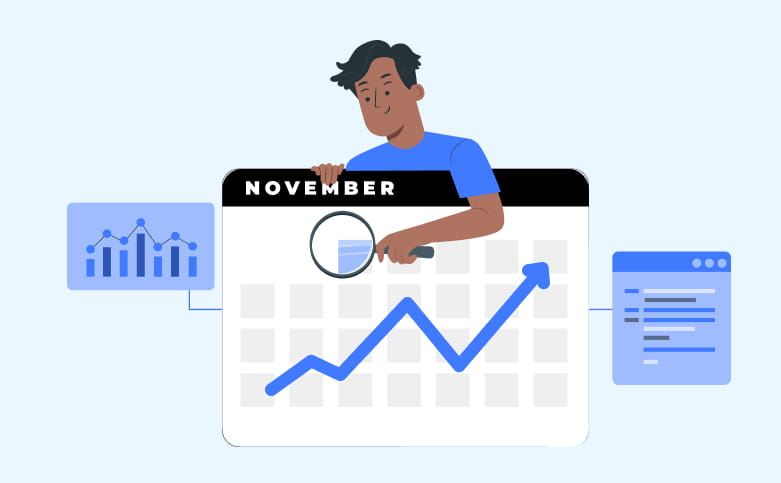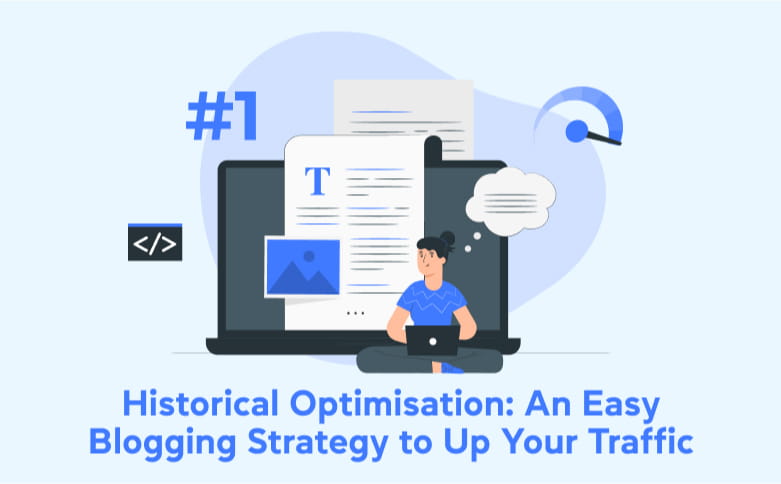Historical Optimisation: An Easy Blogging Strategy to Up Your Traffic
What good could history be for marketers and website owners? It’s in the past, whereas we, as goal-driven businesspeople, are obsessed with the future.
We want to exceed our past performance by creating and optimising new content. With a focus on tomorrow, many of us can lose sight of a valuable resource hidden under the sands of time—the historical content buried in our archives.
What is Historical Optimisation
Historical optimisation is the technique to get more traffic and leads from your existing blog content. No matter if you published a post last month or five years ago, you can get more traffic from it today.
How much more traffic?
Hubspot reported optimising their old content delivered a more than 100% jump in traffic. A performance like that could be a game changer if you use blogging as a marketing channel.
So, how do you optimise the past?

You don’t need a time machine to optimise historical content. Just a few simple tools and techniques will do. Stick to the following blueprint to optimise the past and get successfully back to the future.
Things to Do Before Optimising Old Content
- Spend some time optimising technical elements such as page speed, mobile friendliness, crawlability, and other issues that undermine the user experience and may affect your SEO ranking.
- Historical optimisation should not stop you from creating new content. Follow a hybrid approach and allocate your time and resources between old and new content.
Steps for Optimising Historical Content
Identify Underperforming Blog Posts
If you’ve been blogging for a few years, there may be hundreds of articles that you could optimise. It’s important to prioritise content that needs revamping if you don’t want to waste time.
Log into Google Search Console and view the performance report. Can you see any old blog pages that could do better, based on their titles and target keywords? Make a list of posts that are not performing well but have the potential to bring in significant business.
Identify Missing High Intent Keywords
Identify relevant keywords for each historical piece and optimise the content accordingly. Conduct keyword research using tools like Google Keyword Planner or SEMrush to identify keywords with a reasonable search volume and low competition.
Integrate these keywords naturally throughout the content, including headings, subheadings, and meta tags.
Update Outdated Information
Review each piece of historical content for accuracy and relevance. Remove or update any outdated information, statistics, or references that no longer hold true.
Ensure that the content reflects the latest industry trends and developments. Add new examples, external links and case studies to ensure that the content looks fresh
Improve Formatting and Readability
Enhance the readability of older content by improving its structure and formatting. Break up large chunks of text into shorter paragraphs, use subheadings to organise information, and incorporate bullet points and numbered lists where appropriate.
Make sure that the content is scannable by using clear headings and highlighting important points.
Add and Update Visual Elements
Consider adding relevant images, infographics, or videos to your historical content to make it more visually appealing and shareable on social media platforms.
Add keyword-rich alt descriptions for all images and titles and descriptions for videos to make them appear during image and video searches.
Update Internal Linking
Leverage internal linking to connect your older content with newer posts or pages. Identify relevant anchor text within your historical content and link it to other relevant pages on your site.
This not only helps search engines discover and index your content but also improves the overall user experience by providing additional context and resources.
Optimise Old Content for Conversions
Ideally, each blog article in your archive addresses specific stages in the buyer’s journey: Top of the Funnel (TOFU), Middle of the Funnel (MOFU), and Bottom of the Funnel (BOFU).
By knowing the search intent of the reader, you can optimise that piece for conversions. For example:
- TOFU customers are searching for more information about your product, so you can offer them a whitepaper in exchange for their email address
- BOFU customers are comparing alternatives, so you can link to a blog post that reviews the alternatives in your industry
- TOFU customers are ready to buy, so you can point them to your sales pages
Promote and Repurpose Updated Content
Once you’ve optimised your historical content, don’t forget to promote it. Share the updated posts across your social media channels, email newsletters, and other distribution channels to attract new traffic and generate engagement.
You can also repurpose old blog content for different formats, such as videos, podcasts, infographics, or slideshows. This allows you to reach audiences who prefer different types of media and extends the lifespan of your content across multiple platforms.
The content that you produced in the past cost time and money. Historical optimisation offers a compelling opportunity to breathe new life into your older content. By investing time and effort in optimising the past, site owners can squeeze out optimal traffic and conversions from their forgotten blog articles, maximising their ROI.
Contact the team at eMarket Experts, Melbourne’s most awarded digital marketing agency today. We can help you get the most out of your existing blog content, create new content or build you an SEO content strategy from the ground up.








